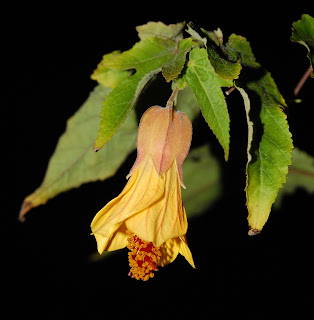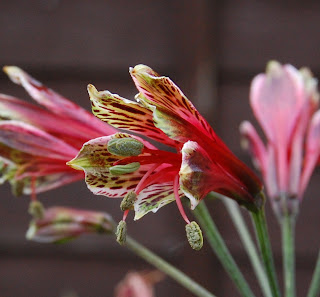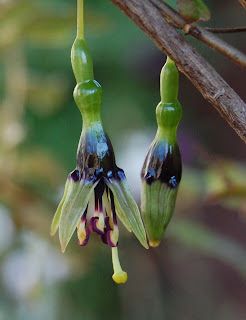Ok, I've nicked this idea from Chrissyboi here!
The first one is easy; Clerodendrum Ugandense......
I've already covered it in a separate post (here), so quickly on to my next choice. This is Tibouchina urvilleana.......
I bought this from a charity plant sale for 99 pence, not really knowing what it was. Hell of a good result though, even if it's a bit of a fussy plant to care for, Overwater it and the buds drop, same if you keep it too dry as well. And never, ever give it tap water unless you want the leaves to develop nasty white growths!
Both of my first two choices are tender, but the next one is fully hardy. I would have to have at least one Toad Lily, and if I had to select just one it would have to be Taiwan Adbane......
Another tender one next - Abutilon Victory........
There is a little indecision depending on which source that to use as to whether it is hardy or not. As it's one of my favourites though, I'm not taking any chances!
My fifth choice is a plant that I never though that I'd bother with - Alstromeria. I've always found them a little too "busy" for my taste, but this A.psittacina "Royal Star" is different; The flowers are longer and thinner than the common A.aurea, borne on stems of a metre or more........
Fully hardy too.
Fuchsia Perscandens is a native scrambling Fuchsia from New Zealand.......
Lobellia cardinalis "Queen Victoria" is my favourite garden plant. Young plants up to a couple of years old tend to be fully hardy, but after that they can be a little hit and miss, so it's a good idea come September time to pot up the small offsets in order to over winter these undercover and plant out in the spring.
Another tender plant for my next choice, this time from Mexico. Polyanthese Tuberosa.....
If you want it to flower for you, do not expose it to temperatures below 20 deg c. It will handle temperatures down to pretty much freezing, but you won't get the incredibly fragrant flowers, so it's best grown in a pot so that you can bring it in at night.
My penultimate choice is Digitalis Lunata Lutea........
Hopefully, this will have seeded itself all over a little corner of my little garden next year!
My final choice is a bit of a cheat as I have two forms of this; Sollya Heterophylla........
It's common name is the Bluebell Creeper and it is an Australian native. As you can see though it is available in both blue and white forms. Apart from being tender (again) and susceptible to red spider mite, it needs very little care and will reward you with masses of the small (6 to 8mm) flowers all summer long.
I'm not going to proof read this, cos if I do I'll be here all night shuffling plants around that I think should be in (sometimes it's just best to dive in without too much thought!) so please forgive any typos or spelling/grammar mistakes!
Have fun!



.jpg)







I've found that Tibouchina is easy to root from semi-hardwood cuttings in late spring, that then flower well in the following spring. When the plants are more that about 18 months old and begin to become woody they lose their shape and the branches tend to snap easily. First time I sawClerodendron ugandense I thought it was covered in a swarm of blue butterflies too - I wonder if it mimicks butterflies to attract them as pollinators? Cheer, Phil
ReplyDeleteIt will be difficult for my Tibouchina to lose it's shape as it's never had one! I'll try a couple of cuttings come spring just in case. I saw a fantastic specimen at Pine Lodge Gardens nursery near St. Austell in September, just before my small plant burst into bloom - either the water agrees with it their or they have a fine rainwater collection system.
ReplyDeleteThat has to be the only realistic answer with regards to the flower shape of C.ugandense. The question it always raises for me is that whilst these plants "mutate" over the centuries, how did they continue to prosper?
Clerodendrum Ugandense is beautiful. The flower is really unique and attractive. I wonder if this plant more suited for sub-tropical than tropical. Do you plant this in the shade or full sun?
ReplyDeletePS: Sollya Heterophylla is a beauty too. But this plant may not be found here ;-(
ReplyDeleteStephanie - as the name suggests, the plant originates from Uganda, which is generally a tropical climate. The flowers are however spoilt by rain.
ReplyDeleteHere in the UK I have to grow it in a pot. I leave it in full sun outside during the summer, making sure that it gets plenty of water. This seems to be a requirement of most Clerodendrum species.
Sollya heterophylla is native to the south western corner of Australia, although it is becoming naturalised in many areas of the southern half of Australia. I would have thought that your heat would be ok with it, although it may well be physically damaged by your monsoonal rain! Maybe you could source seeds on the web....
Got it Keith! Thanks for sharing. Your information is very helpful :-D Btw, once rain, even hibiscus flowers will fall to the ground ;-)
ReplyDelete